[Because what Overthinking It really needs is more Matts, we present this BTTF guest post from Matthew Silver. —Ed.]
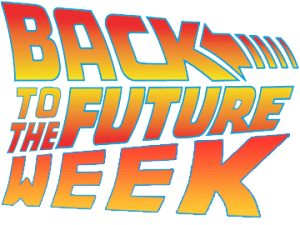 Arguably, no movie involving time travel can ever actually make sense in the realm of continuity. I have to give tremendous credit to the Back To The Future writers for taking it on in the first place. This series has it all: paradox, parallel timelines, and altering history both past and future.
Arguably, no movie involving time travel can ever actually make sense in the realm of continuity. I have to give tremendous credit to the Back To The Future writers for taking it on in the first place. This series has it all: paradox, parallel timelines, and altering history both past and future.
As an audience, we all cope with the discrepancies in different ways. Some of us rationalize the impossible because it’s the only way we can enjoy the reality presented to us. (Have you seen Heroes this season?) Some of us believe wholeheartedly in “suspension of disbelief” and are all too understanding of the limitations of Hollywood (Ross, Joey, and Chandler love the Die Hard films, yet they don’t hesitate to accept Bruce Willis when he shows up on Friends as a guest character). And then there are those of us who just unconditionally believe everything we see and hear. [Not on this site. —Ed.]
For those of us who will never be satisfied without a little digging, I present the following theories.
We’re all familiar with this example of a paradox because it drives the plot for Part 2: As Marty and Doc are distracted in the future, old Biff steals their time machine and goes back in time to hand his past self a sports almanac. This creates a paradox that even Doc Brown himself admits could be disastrous, since a person interacting with him/herself in the past or future could destroy the universe.
Traditional Timeline Theory
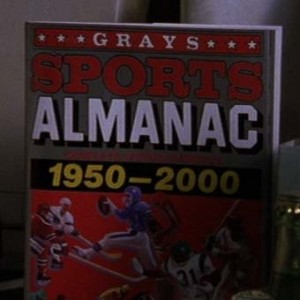
Doc Brown’s revelation implies that he subscribes to traditional timeline theory, in which there exists one single timeline. Not being a member of clergy, I can’t speak specifically to what in life could actually trigger an apocalypse, but I do agree that Doc presents a major paradox: According to this theory, old Biff should be creating memories for himself at the exact same time he speaks to his younger self, which could be disconcerting to say the least.
Furthermore, by handing himself that book, he is altering young Biff’s path so significantly that old Biff should have a completely different personality. For one, young Biff now becomes extremely rich and powerful which would make anyone a different person in the future; and for another, this new Biff probably doesn’t have a reason to go back in time and hand himself the book in this newly created future, thus severing the circle of time.
Predestined Timeline Theory
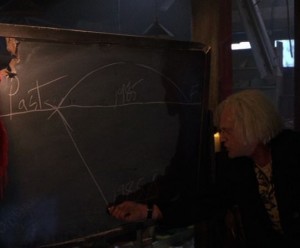
He walks the line.
In order to account for these discrepancies without completely discarding Doc’s belief in traditional time travel theory, we have to assume that the “final” timeline is predestined.
For example, when Marty and Doc travel back in time and discover Biff’s alternate reality, this is a temporary tangent, not the “final” timeline. Ultimately, Marty does recover the almanac from young Biff and restores his original reality.
Even though Marty doesn’t save the day until the end of the movie, this certainly doesn’t mean that it hasn’t already happened in the “predestined” timeline. We don’t follow old Biff’s story once he returns to the future, but his plan could have already failed, assuming the predestined timeline prevails.
Displaced Timeline Theory
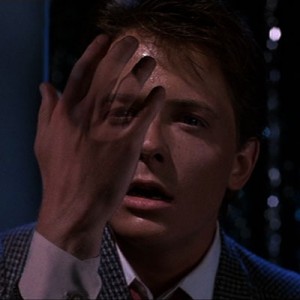
That's just bad compositing. Oh, also it's a rip in the space time continuum in the process of being "reset."
Even with a predestined timeline, these theories are certainly not without their paradoxes. Each timeline does “exist”—we see them both in the movie. So which timeline is real?
Apparently, the answer is in the eye of the beholder. Only our heroes, the time travelers, are aware of the transition. (Why doesn’t Marty have any memory of his new past?)
This brings us to the theory of a displaced timeline, in which we assume that a significant change in the fabric of time will cause it to rip. In order to heal itself, it must reset to allow for this alteration. This “reset,” however, takes time (as evidenced by Marty slowly being erased from existence in Part 1), suggesting that the time travelers have a chance to “repair” the altered fabric before it resets.
Following this thinking, if Marty and Doc had taken too long to retrieve the almanac from young Biff, their memories would have reset to the new “healed” timeline (where Marty is Biff’s stepson and Doc has been committed). Sadly, this theory hits a snag here – what happens when there are multiple time travelers at once? I’m not even going to begin to pretend that I can wrap my head around that one. Puzzle it out in the comments, if you can.
Tapestry Timeline Theory
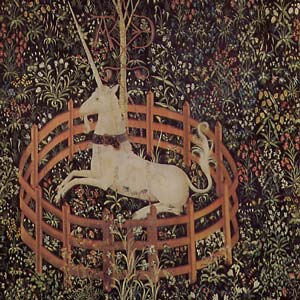 Let’s think outside the box. Let’s say that life is a “tapestry” of time, with various threads moving about in different directions, sometimes converging, but never traveling along one straight timeline.
Let’s think outside the box. Let’s say that life is a “tapestry” of time, with various threads moving about in different directions, sometimes converging, but never traveling along one straight timeline.
When old Biff travels back in time, he could actually jump to another thread and create an alternate reality different from his original reality. Marty and Doc don’t notice the difference until they travel back in time and discover the altered thread in their originating time.
This theory offers an explanation for why the entire world doesn’t change around Marty and Doc in the exact instant that Biff disappears in the stolen time machine (as it would on a single timeline), and why Doc believes it would be fruitless to return to the future once they’d traveled back in time and discovered what Biff had done.
I don’t think that the writers of Back To The Future took any theories into consideration beyond traditional, and since traditional theory is flawed, I can only assume that they hoped suspension of disbelief would fill in the gaps. I can’t really blame them, because after all Back To The Future is a family movie aimed at the more casual time traveler.
With all the paradox, altered realities, and suspension of disbelief, why then are we able to smile and love this series? I guess because it’s awesome. Honestly, the only real travesty is that it is now closer to 2015 than 1985, and we don’t have hoverboards, or movie posters replaced by giant holographic sharks.
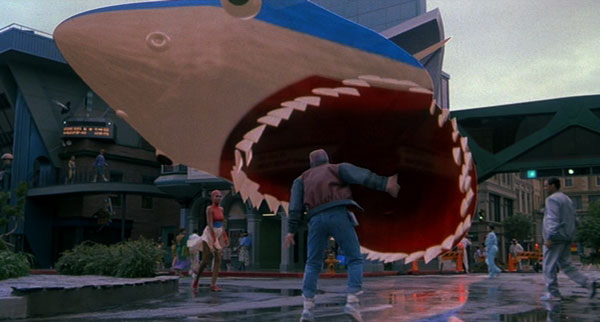
Marty lives every week like it's Shark Week.
If you have (ahem) time on your hands, I’d be curious if you find that any of these theories fit elsewhere. The theories behind Lost may be unanswerable until 2010, but it seems to be playing out a combination of predestined and displaced timelines. And this one is a bit more esoteric, but if you’ve heard of an old video game called Shadow of Destiny, it’s an excellent example of tapestry timeline theory.
Email Matthew Silver at silver dot matthew at gmail dot com.
![How Time Travel Works (and doesn't) in Back To The Future [BTTF Week]](https://www.overthinkingit.com/wp-content/uploads/2009/01/silver-articleimage.jpg)
I’m very curious about the moment when Old Biff returns to 2015 after dropping off the Almanac. Now presumably, it’s the same reality that he left. But how can this be? When MARTY travels back in time in Part 1 and changes the future, and then goes back to the future, things are different.
Short answer: Biff HAD to come back to the same 2015, because otherwise Marty and Doc would have lost their time machine and the movie would have ended.
For a more “realistic” depiction of how time travel might work, check out the movie “Primer.”
I think the explanation of Biff’s return to 2015 was that it was a different reality than the one he left. After he left 1955 the time line changed, giving us the alternate 1985 and an alternate 2015. Marty, Doc and Jennifer had left the house and were on their way back to the time machine when Biff pulled up – presumably the house they just left could have transformed around them into another family’s house had they not already left.
I like that Biff apparently suffers a heart attack upon arriving in 2015, signaling that, maybe, his actions in the past caught up with him in the future.
Suzie- I always wondered about that – did Biff have a heart attack or did he just hurt himself trying to pull out his cane? I was under the impression that this was the movie’s way of signaling that Biff left a piece of his cane in the time machine for Doc to find later.
Reposted on my blog.
First, view this primer on 10 dimensional concepts.
http://www.youtube.com/watch?v=HvgwR9ERCBo
Go ahead, I’ll wait.
Okay, we’re all back now? Good, because it’s actually rather elegant. We like to think of time machines as capable of traveling the fourth dimension. Now that’s a reasonable understanding because that’s how we’re used to fourth dimensional travel: each of us moves through the fourth dimension at a constant direction at a constant rate (well, constant as long as we don’t get too close to a hyperdense object, but that’s another tangent). We thus think of time machines as moving in the same manner but in either direction and at a variable rate.
That’s not what Doc Brown has constructed, however. When Biff alters the timeline he creates a split that leads into an alternate timeline via 5th dimensional space. When Marty alters the past he directs the future to another 5th dimensional path. But we’re not 5th dimensional creatures; we can’t perceive on those planes, although we can abstract about them. Neither is the Delorean. The Delorean travels through the fifth dimension by a combination of guidance through the input panel and 5th dimensional sensors that locate the path of least resistance.
Consider the following timelines (a.k.a. 5th dimensional splits).
T(1) – The original timeline from the start of the first movie.
T(2) – The improved timeline at the end of the first movie.
T(3) – The bad timeline where Biff runs Hill Valley (halfway through second movie).
T(4) – Final timeline from third movie (only notable change: stupid name for ravine).
Because timelines are not straight but only appear straight to us (remember that bit on the ant on the Mobius strip?) we can assume that they have areas of greater and lesser resistance. Third-dimension creatures, like us, simply have to persevere ever onward, but because the Delorean is a fifth dimensional transport, albeit a primitive one, it can traverse the splits but with little control, and thus settles into whichever timeline is most convenient.
When Marty changed the past it changed T(1) to a branch and made T(2) straight, thus he naturally traveled to T(2) where his parents were awesome, his sister was hot, and rock and roll was invented by white guys (not really). When Biff traveled back and gave himself the sports almanac it made the path to T(3) easier and the path to T(2) much harder as long as the path wasn’t reset. For Marty and Doc, that meant they would naturally follow T(3), then reset the fold for everyone else so that old Biff would go back to the future of T(2).
Suzie –
I see what you’re getting at. But it doesn’t quite work. You’re saying reality changes the second Old Biff returns to 2015. But why should this be? If Biff changes the timeline, then everything that happened in the movie up to that point is magically wiped away, which means Marty and Doc are never in 2015 to begin with, which means… eh, someone else take over.
Matt: Biff fades away right after he returns to 2015. It’s a deleted scene on the DVD. Cut because audiences didn’t quite get it. Not sure I get it either.
I must always fill in the blanks like a casual viewer but I’ve never time travelled so it’s only an assumption.
When Biff travels from the past, the actual point in time he has just left still leads to the original 2015. If young Biff had won his millions whilst old Biff was still there I assumed that would then be the alternate future. As he had to wait until his 21st birthday Old Biff was not leaving from an altered timeline simply entering one.
I also assumed that no matter how much we f*$? up the timeline the world is programmed to correct itself. It would be so irresponsible to leave two people in the future who are supposed to already exist there but much older. :) I’ll bet there’s so much I don’t know or understand!
http://www.youtube.com/watch?v=SrpkWP2yCiw
DC Comics tried to introduce the concept of “hypertime” a little while ago in an effort to clean up their continuity. The basic theory was, every story they ever published happened, even if it contradicted other stuff. Eddies in the space-time continuum. They gave it up pretty quickly but it was an interesting idea (if implemented poorly)
Hell, comic continuity in general seems very similar to the “tapestry timeline” concept.
The New old Biff fades away in 2015 because Lorraine kills him some time in 1994
Remember, it takes awhile for time to catch up. Like in part 1, it took an entire week for Marty to start fading out of existence. So it would take awhile for people/things in 2015 to start changing too.
The reason Biff “has a heart attack” is because he’s slowly fading away. This is because he was killed a some point before 2015, whereas he still existed in the previous timeline.
Come to think of it, though, that doesn’t quite work either. Because days later, Doc finds the top of Old Biff’s cane in the Delorean. Wouldn’t that have disappeared too? Maybe it was just a simple heart attack. Biff must have spent 60 years eating greasier foods than in the previous timeline.
If you want a very well-thought out analysis of paradoxes in the BTTF movie(based on a certain “correctable” single-timeline theory), check out:
http://www.mjyoung.net/time/back1.html
The basic gist of his theory is that time travel backwards is OK so long as you don’t change anything significant enough to prevent your going back in time in the “first” place – what he calls a N-jump. Going forward in time is easy – it’s basically the same as being frozen somewhere for X number of years – but once you are in the future, going back to the “present” is the same thing as backward time travel – meaning you can’t change anything any more. Also, in this theory you would disappear for the intervening years, meaning that Marty would never find himself or his family in 2015…
Unfortunately, none of the BTTF movies offer a satisfying storyline with only “N-jump” non-paradoxical explanations.
However, one time travel movie that the site’s author thinks is almost entirely paradox-proof is 12 Monkeys, which succeeds precisely because everything the time traveler does in that movie is fail.